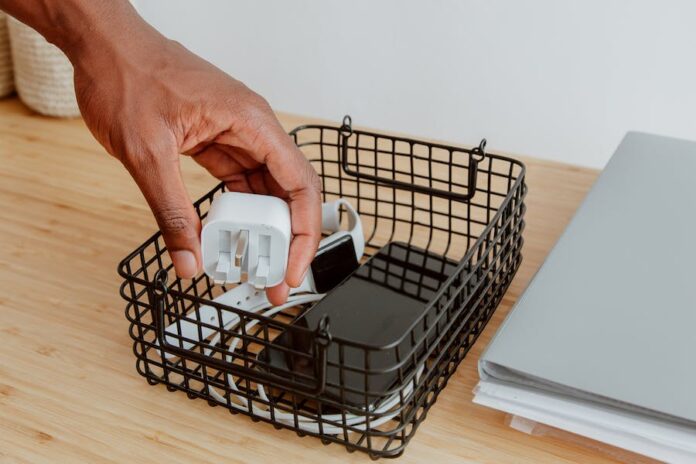Chargers often break due to frequent bending, tugging, or using low-quality cables. Over time, these stressors damage internal wires and connections.
Finding yourself repeatedly replacing chargers can be both frustrating and costly. Chargers are lifelines to our devices, ensuring that smartphones, tablets, and laptops stay powered throughout our busy days. Unfortunately, they’re also prone to breaking. Durability issues arise due to constant use and abuse – from the way we coil them up hastily to the countless times they get yanked out of sockets.
Many chargers aren’t built to withstand this rough treatment, especially those that aren’t from reputable manufacturers. This intro looks at the frequent reasons behind charger breakage and outlines practices that may help extend their lifespan, ensuring that your devices remain juiced up without the annoyance and expense of constantly buying replacements.
The Fragile Life Of Chargers
Chargers power our lives but often fail when we need them most. Understanding why they break can save frustration and money. Let’s look closer at their short life expectancy.
Manufacturing Quality And Lifespan
The quality of a charger significantly influences its durability. Chargers range from high-end to low-cost options. Below are factors impacting their lifespan:
- Materials used: Quality materials ensure longevity.
- Design: Sturdy designs resist damage from drops or bends.
- Production standards: Higher standards lead to durable chargers.
Certifications, like UL or CE, indicate adherence to safety and quality norms. Chargers without these may not last long.
Different Types Of Wear And Tear
Chargers endure various forms of wear. Repeated use degrades them over time. Let’s break down common wear types:
| Type of Wear | Examples | How It Affects Chargers |
|---|---|---|
| Physical Stress | Bending, pulling | Causes breaks in the wire |
| Environmental Factors | Heat, moisture | Leads to corrosion or insulation damage |
| Electrical Surges | Power spikes | Damages internal components |
For a charger to survive daily wear and tear, gentle care is essential. A familiar sight is a frayed cable near the plug. It’s a result of bending and twisting the cable. Easy habits can prevent this, like ejecting the charger from the device or socket with care.

Credit: dailygrindbc.com
Common Mistakes That Damage Chargers
Chargers are essential in our daily lives, keeping our devices powered up and ready to go. Yet, they often break down faster than expected. Understanding the common mistakes that damage chargers can save time and money, and extend the life of these important accessories.
Overlooking Proper Ejection
Rushing to disconnect can harm your charger. Gentle ejection prevents damage to both the cable and the device’s charging port. Remember:
- Always pull the plug, not the cable.
- Check your device’s removal protocol; some may have specific instructions.
Tight Wrapping Techniques
How you handle your charger matters. Wrapping the cord too tightly can strain the wires inside. Consider these tips:
- Loop the cable loosely in a circle.
- Avoid sharp bends or kinks as they can break internal wires.
Extreme Environmental Conditions
Chargers can be sensitive to their environment. High temperatures and moisture rank as top offenders. Keep in mind:
| Condition | Impact on Chargers |
|---|---|
| Heat | Can melt insulation and warp components |
| Cold | May cause brittleness leading to cracks |
| Moisture | Risk of short circuits and corrosion |
The Role Of Power Surges And Voltage Fluctuations
The Role of Power Surges and Voltage Fluctuations often goes unnoticed until you find yourself continually replacing broken chargers. Understanding why chargers break can help you protect your devices and save money. Specifically, power surges and voltage fluctuations play a critical role in diminishing the lifespan of your chargers.
Power Surges Explained
A power surge occurs when the flow of electricity spikes unexpectedly. This can be due to lightning strikes, power outages, or electrical devices turning on and off within your home. Even though these surges last only a few milliseconds, they can cause significant damage to electronic devices, including chargers.
Voltage fluctuations, on the other hand, are variations in the power supply’s voltage level. These can be less dramatic than surges but can still harm electronic components over time, especially delicate ones found in chargers.
Protecting Your Chargers
To protect your chargers from power surges and voltage fluctuations, consider these tips:
- Use surge protectors: Plug your chargers into surge protector power strips to shield them from sudden voltage spikes.
- Unplug during storms: Lightning is a common cause of power surges. Unplug your electronic devices during a storm for an added layer of protection.
- Quality matters: Invest in high-quality chargers that have better components and are more resilient to power surges.
By understanding the role of power surges and voltage fluctuations and taking precautions to guard against them, your chargers stand a much better chance of longevity and reliable performance.
Best Practices For Charger Care
Best Practices for Charger Care begin with understanding how to treat these essential accessories right. Chargers are our gadgets’ lifelines, but they often fail us, succumbing to daily wear and tear. Simple, mindful habits can drastically extend the life of your chargers. Follow these practices to keep your chargers working like new for longer.
Safe Storage Tips
Keep your charger safe and functional with these storage tips:
- Avoid tangling the cords – Gently coil the cable without forcing it into tight loops.
- Stay clear of extreme temperatures – Hot or cold environments can damage your charger.
- Use a dedicated space – Store chargers in a designated drawer or bag to prevent loss or damage.
- Keep them dry – Moisture is a charger’s enemy. Ensure they’re always in dry conditions.
Routine Maintenance And Cleaning
Chargers accumulate dust and debris that can impair their function. Regular cleaning is a must. Here’s how:
| Action | Description |
|---|---|
| Unplug First | Always disconnect your charger from the power source before cleaning. |
| Use the Right Tools | Use a dry cloth or cotton swab to gently wipe the cable and connector. |
| Avoid Liquids | Don’t use water or cleaning solutions as they can cause damage. |
| Regular Check-ups | Inspect for signs of wear like fraying or exposed wires and replace if needed. |
Investing In Durability
Investing in durability can save you the frustration and expense of frequently replacing your chargers. Chargers are vital to keeping our devices powered, but they often fall victim to wear and tear. To combat this, it’s essential to prioritize the lifespan of your charging cables rather than opting for cheaper alternatives that may fail quickly.
Quality Over Price
It might seem tempting to go for the budget-friendly charger, but this could lead to a cycle of constant replacements. Investing in a higher-quality charger might cost more initially, but it pays off in the long run. Cheaper chargers can break easily, while premium ones use better materials and technology, ensuring longevity and better performance.
Recognizing Durable Design Features
Not all chargers are created equal. Spotting durable design features is key to making a wise purchase. Look for chargers with reinforced cable joints, as this is typically where damage occurs. Thick, braided cables resist tangles and wear better than their thin counterparts. Other signs of durability include:
- Sturdy connectors: These resist bending and damage upon insertion and removal.
- Metal casing: Offers additional protection against drops and impacts.
- Lengthy warranty: Indicates the manufacturer’s confidence in their product’s durability.
When selecting a charger, scrutinize build quality and user reviews. Both can offer insight into the charger’s long-term viability. A durable charger not only outlasts cheaper alternatives, but it also helps to avoid the inconvenience of a sudden loss of charge when you need it most.

Credit: sweepinghands.com

Credit: dailygrindbc.com
Frequently Asked Questions For Why Do My Chargers Keep Breaking
How Do I Stop My Charger From Breaking?
To prevent your charger from breaking, gently insert and remove it from devices. Avoid bending the cable, especially near the connectors. Don’t wrap cords tightly; instead, loosely coil them. Keep the charger away from heat and moisture, and avoid yanking the cord out of the power outlet.
Why Do My Chargers Stop Working So Quickly?
Chargers may stop working quickly due to frayed cables, frequent bending, overcharging, or using incompatible devices. Poor-quality chargers can also wear out faster. Regularly check for physical damage and use chargers as recommended to extend their lifespan.
Why Does Every Charger Break?
Chargers break due to frequent use, bending of cables, and exposure to heat or moisture. Poor build quality and mishandling can also contribute to charger failure. Regular wear and tear ultimately cause most chargers to fail.
Why Do My Chargers Keep Going Bad?
Chargers may go bad due to frequent overcharging, using incompatible devices, exposure to extreme temperatures, or poor-quality manufacturing. Ensure proper use and invest in certified chargers for longevity.
Conclusion
Frequent charger failures can be frustrating. Optimize their lifespan by choosing quality cables, proper handling, and avoiding overcharging. Recognize the signs of wear and intervene early. Your gadgets will thank you with uninterrupted performance, and your wallet will feel the relief.
Embrace these habits, and break the cycle of charger breakage.





